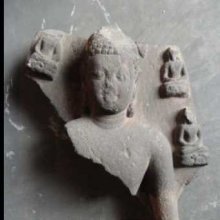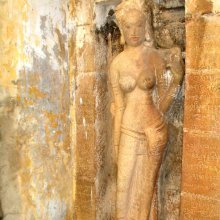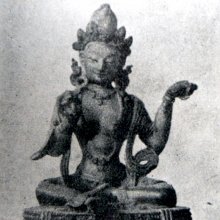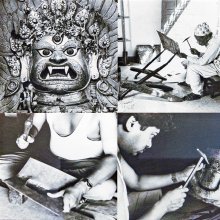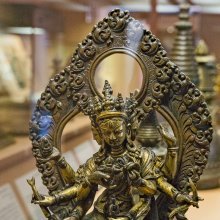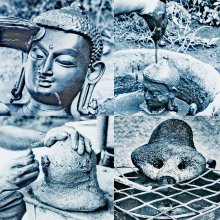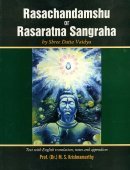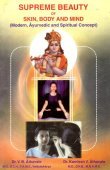Quality: 2 definitions
Introduction:
Quality means something in Hinduism, Sanskrit. If you want to know the exact meaning, history, etymology or English translation of this term then check out the descriptions on this page. Add your comment or reference to a book if you want to contribute to this summary article.
Images (photo gallery)
(+4 more images available)
In Hinduism
Ayurveda (science of life)
Source: INSA Digital Repository: Caraka’s Approach to KnowledgeQuality (Sanskrit: guṇa) refers to one of the various Padarthas (categories of all that exists) which were adapted by Caraka in his Charakasamhita.—Vaisheshika was an ancient system dating back to the time of the Buddha and drew within its fold ‘physics, metaphysics, and logical discussions skillfully dovetailed’ (Cf. Charaka Samhita verse 11.44-56).—[...] The primary classification of Padarthas into substance, quality (guṇa), activity, generality, particularity and inherence was adopted by Charaka without changes. But other adoptions from Vaisheshika were qualified.

Āyurveda (आयुर्वेद, ayurveda) is a branch of Indian science dealing with medicine, herbalism, taxology, anatomy, surgery, alchemy and related topics. Traditional practice of Āyurveda in ancient India dates back to at least the first millenium BC. Literature is commonly written in Sanskrit using various poetic metres.
Shilpashastra (iconography)
Source: Shodhganga: Elements of Art and Architecture in the Trtiyakhanda of the Visnudharmottarapurana (shilpa)The Qualities (of a good painting) are to be derived from the six limbs of Painting (citra), according to the Kāmasūtra and Viṣṇudharmottarapurāṇa, an ancient Sanskrit text which (being encyclopedic in nature) deals with a variety of cultural topics such as arts, architecture, music, grammar and astronomy.—The Viṣṇudharmottarapurāṇa says that proper position, measurement, use of space, gracefulness, expression, similarity, scale of size to increase or to decrease are the eight qualities of a good Painting.

Shilpashastra (शिल्पशास्त्र, śilpaśāstra) represents the ancient Indian science (shastra) of creative arts (shilpa) such as sculpture, iconography and painting. Closely related to Vastushastra (architecture), they often share the same literature.
See also (Relevant definitions)
Full-text (+8229): Guna, Nirguna, Saguna, Viguna, Shadguna, Gunin, Aguna, Tamoguna, Vaigunya, Bahuguna, Nairgunya, Sattva, Triguna, Rajasa, Gunatas, Gunasanga, Savishesha, Durguna, Gunavattva, Tamas.
Relevant text
Search found 469 books and stories containing Quality; (plurals include: Qualities). You can also click to the full overview containing English textual excerpts. Below are direct links for the most relevant articles:
Nyaya-Vaisheshika categories (Study) (by Diptimani Goswami)
The Nature of Substance (Dravya) < [Chapter 3 - Dravya (Substance)]
Different Types of Quality (Introduction) < [Chapter 4 - Quality and Action]
Divisions of Quality < [Chapter 4 - Quality and Action]
Taittiriya Upanishad Bhashya Vartika (by R. Balasubramanian)
Verse 2.152 < [Book 2 - Brahmavallī]
Verse 2.155 < [Book 2 - Brahmavallī]
Verse 2.52 < [Book 2 - Brahmavallī]
Padarthadharmasamgraha and Nyayakandali (by Ganganatha Jha)
Text 46 < [Chapter 6a - On Qualities]
Text 5 < [Chapter 2 - Enumeration and Classification of Categories]
Text 160 < [Chapter 9 - On Samavāya (Inherence)]
Yoga-sutras (with Vyasa and Vachaspati Mishra) (by Rama Prasada)
Sūtra 3.13 < [Book 3 - Attainment (Vibhūti or Siddhi)]
Sūtra 3.49 < [Book 3 - Attainment (Vibhūti or Siddhi)]
Sūtra 3.46 < [Book 3 - Attainment (Vibhūti or Siddhi)]
The Tattvasangraha [with commentary] (by Ganganatha Jha)
Verse 634 < [Chapter 11 - On ‘Quality’ as a Category]
Verse 622 < [Chapter 10 - The Examination of the First Category—‘Substance’]
Verse 652 < [Chapter 11 - On ‘Quality’ as a Category]
The Patthanuddesa Dipani (by Mahathera Ledi Sayadaw)
Related products
(+116 more products available)
